June 16, 2025 | 09:46 GMT +7
June 16, 2025 | 09:46 GMT +7
Hotline: 0913.378.918
June 16, 2025 | 09:46 GMT +7
Hotline: 0913.378.918
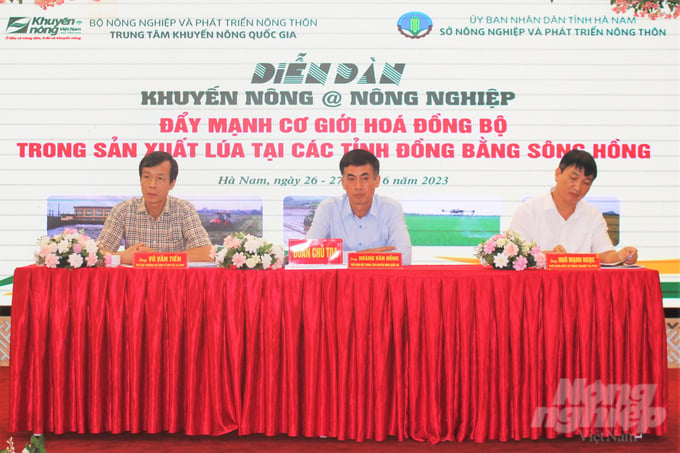
Forum on Agricultural Extension @ Agriculture “Strengthening synchronous mechanization in rice production in the Red River Delta provinces” in Ha Nam. Photo: Trung Quan.
In collaboration with the Department of Economic Cooperation and Rural Development (MARD) and the Ha Nam Department of Agriculture and Rural Development, the National Agricultural Extension Center (NAEC) hosted the Forum on Agricultural Extension @ Agriculture entitled "Strengthening synchronous mechanization in rice production in Red Rive Delta" in Ha Nam.
The purpose of the forum is to assist production households, cooperation groups, and cooperatives in comprehending directions, policies, and solutions pertaining to science and technology in agricultural production, thereby promoting synchronous mechanization in production to reduce input costs, protect the environment, and improve economic efficacy. Consequently, the formation of a large-scale, centralized production region for products, in the direction of modern, high-tech, and sustainable agriculture.
During the forum, delegates discussed mechanisms and policies to strengthen synchronous mechanization in production; land concentration; support and promote agricultural service groups and service cooperatives; experience and methods in promoting synchronous mechanization in rice production; advanced techniques on synchronous mechanization in rice production in RRD; discuss applying the motto "one region, one variety, one time" to maximize the application area of mech; and discuss applying the motto "one region, one variety, one time" to maximize the application area
According to NAEC, the rate of mechanization application in rice production in RRD has been demonstrated in several phases, including soil tilling, irrigation (reaching over 90 percent), pesticide application (80 percent), harvest (80 percent), and delivery (over 75 percent). In some stages, such as rice transplanter (approximately 12 percent) and dehydrating (approximately 20 percent), the level of mechanization is still modest.
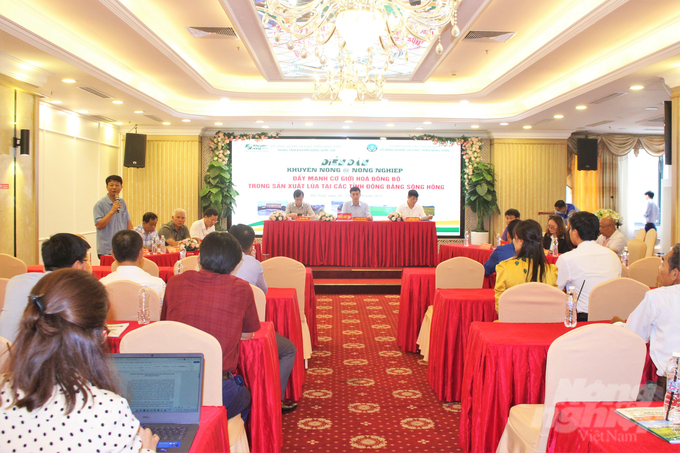
At the forum, many delegates raised opinions on difficulties, obstacles, and proposed solutions to promote the application of mechanization in agricultural production in the Red River Delta provinces. Photo: Trung Quan.
In the RRD, 98 percent of households have less than 0.5 ha per household. Nearly 47% of fields have an area of less than 500 square meters, while only 5% have an area greater than 2,000 square meters. The rate of loss during harvesting is still high (twice as much as the machine manufacturer recommends); the preservation scale is small and dispersed, and the rate of loss is high.
According to the Institute of Agricultural Mechatronics and Post-Harvest Technology (MARD), the current stage of rice preservation is still modest and dispersed, with service households and vendors, cooperatives, and cooperative groups assuming the responsibilities. Due to capacity constraints, rice is primarily stored in unqualified warehouses, resulting in poor quality and a high loss rate.
In addition, the rate of rice dehydration by machine is still quite low, at approximately 20%. Regarding drying technology and equipment, with the exception of a few large-scale rice milling and refining businesses that use tower dryers, the remainder is dried using horizontal static dryers and is dried directly. The drier requires manual charges and discharges, so in addition to its poor drying quality, it is also laborious.
Domestic mechanics have not yet met the demand for agricultural machinery and equipment in terms of type, quantity, and quality (approximately 33% of the demand for mechanical products).

The application of mechanization helps to free up labor, increase labor productivity, meet the crop process, and reduce losses during and post-harvest. Photo: Trung Quan.
The policy mechanism has been issued in a relatively comprehensive manner, but its implementation remains limited and inconsistent, particularly in the financial mechanism due to limited resources.
Numerous delegates also stated that promoting the application of synchronous mechanization to production in the provinces of the Red River Delta is still hampered by the fact that infrastructure planning in agricultural production regions has not yet fulfilled the requirements of fundamental development. Modernization and globalization. Scale, slope, and levelness of the land; irrigation systems and channels; decentralized and unsuitable for mechanization inland roads.
People's access to lending remains constrained by the absence of collateral. The mechanism to support development investment credit for agricultural machinery and equipment manufacturing facilities is not attractive to mechanical investment establishments, etc.
Mr. Hoang Van Hong, the Deputy Director of the NAEC, stated that the implementation of mechanization would assist in increasing production, freeing up manpower to respond to crop processes, and overcoming labor shortages during peak seasons and unfavorable weather conditions. In addition, it serves to reduce production costs, increase farmers' income, and decrease harvest losses.

Delegates visited the model of the Tien Tai service team for tray seedlings production, and transplanting machine in Thanh Nguyen commune, Thanh Liem district, Ha Nam. Photo: Trung Quan.
Mechanization encourages the accumulation of land, the formation of large fields, and the development of cooperative relationships and links in commodity production. The extensive use of mechanical machinery will be an essential requirement for rural areas to attract youthful skilled employees.
Mr. Ngo Manh Ngoc, Deputy Director of the Ha Nam Department of Agriculture and Rural Development, analyzed the actual production situation in Ha Nam to demonstrate that the implementation of synchronous mechanization is the key to enhancing rice production's value. The introduction of machinery into production facilitates the formation of large fields, which is useful for unifying the structure of varieties and seasons, reducing production costs and labor, and enticing businesses to purchase products for the formation of a new supply chain link. As a result, producers' profits are increased by 15 to 20% compared to the previous conventional method.

The application of mechanization is not only done individually at each stage but must be carried out synchronously at all stages of the production process. Photo: Trung Quan.
Many production households and cooperatives suggested at the forum that, in order to effectively apply mechanization to rice production, state management agencies at all levels should study mechanisms and policies to support seedling tray - transplanting machines, as well as promote the implementation of consolidation and exchange of plots to form concentrated production fields, creating conditions for people to continue to have access to loans with low-interest rates, and training programs.
Translated by Linh Linh
/2025/06/12/3721-2-202745_83.jpg)
(VAN) TH made an impression at Seoul Food 2025 with its line of natural beverages, paving the way for Vietnamese food products to enter the South Korean market.
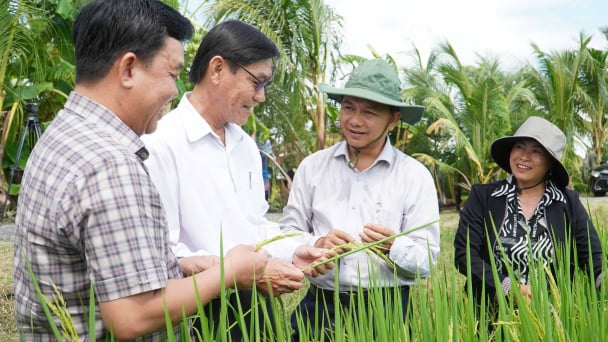
(VAN) Soc Trang's success in rice exports stems from a strategy of developing fragrant and specialty rice cultivation areas and standardizing production toward low-emission practices.
/2025/06/11/1311-5-120811_839.jpg)
(VAN) The pig farming industry is facing the challenge of comprehensive restructuring to meet requirements for quality, safety, traceability, and market expansion both domestically and for export.
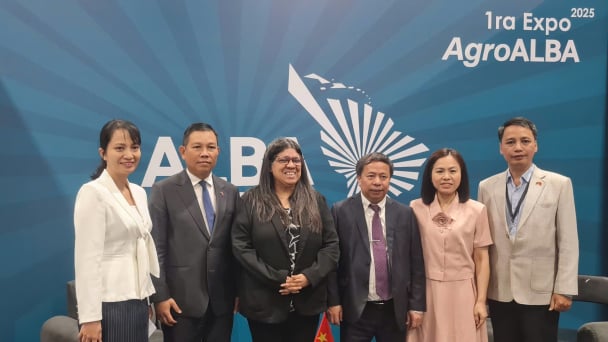
(VAN) Vietnam considers participating in ALGROALBA in order to expand agricultural production, coordinate the assessment and effective exploitation potential land.
/2025/06/05/5314-1-184727_407.jpg)
(VAN) From seemingly worthless fish scales and skin, enzymes and lactic ferments can transform by-products into peptides, opening a sustainable, effective business direction and elevating Vietnamese seafood.
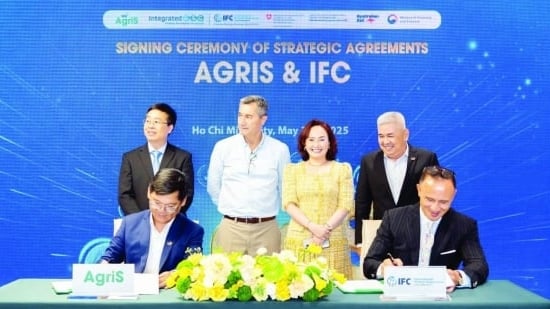
(VAN) TTC AgriS and IFC signed a strategic partnership to develop a sustainable agricultural value chain, aiming to achieve the Net Zero target by 2035.
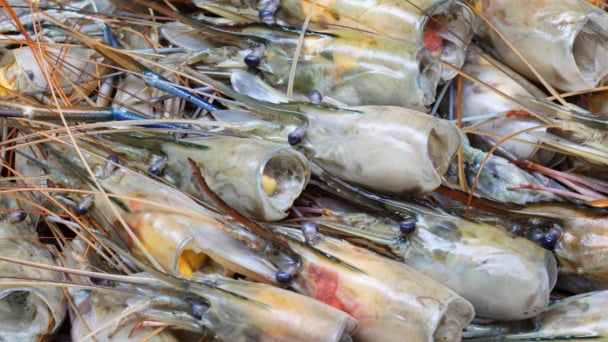
(VAN) Seafood by-products are opening a new path, combining green growth and technological innovation to enhance the industry's value.